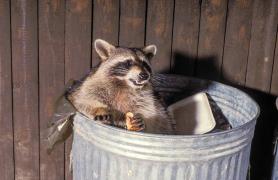It takes special superpowers to live on Missouri’s glades. Everybody knows that scorpions and roadrunners live in hot, dry, cactus-filled deserts. The Show-Me State doesn’t have sand dunes, but we do have a few areas where desert critters make their home. These little hot spots are called glades.
In Missouri, you’ll find glades mostly on south- or west-facing slopes in the Ozarks, where layers of rock jut through the surface in forests, woods, and prairies. Let’s take a look at some of the awesomely adapted plants and animals that live there.
Super-Powerful Plants
If you’re a glade plant, you need ways to live without much water. Prickly pear cactus stores water in its thick leaves to use in times of drought. Hoary puccoon has tiny hairs to slow water’s evaporationfrom its stems. Prairie dock has superlong roots that wind through cracks in the rock, seeking water deep down in the ground. Rock-hugging plants like mosses trap water in spongy mats.
Kinds of Glades and Where to See Them
Glades take their names from the type of bedrock they form on.
Limestone glades — Limestone is a crumbly, holey, cool-looking sedimentary rock made from layers of calcium carbonate and bits of fossilized coral and seashells.
- Rocky Barrens Conservation Area
- Springfield Conservation Nature Center
- Wilson’s Creek National Battlefield
Dolomite glades — Dolomite is a mineral that makes up a coarser, harder kind of limestone.
- Victoria Glades Conservation Area
- Ha Ha Tonka State Park
- Henning Conservation Area
Chert glades — Chert is a hard, sedimentary rock related to flint. These glades are found along streams near Joplin in southwest Missouri.
- Wildcat Glade Natural Area
Sandstone glades — Yet another kind of sedimentary rock, sandstone is made up of tiny specks of sparkly quartz or feldspar.
- Graham Cave State Park
Igneous glades — “Igneous” means “volcanic.” The rocks that form the knobs, mountains, and shut-ins in southeast Missouri hardened from ancient lava flows.
- Ketcherside Mountain Conservation Area
- Hughes Mountain Natural Area
Amazing Animal Adaptations
If you’re a glade animal, you need ways to escape the scorching heat and the many other animals that want to eat you. The eastern small-footed bat lives among trees at the glade’s edge. It sleeps under rocks or tree bark during the day, and at night it flits around the glade’s open areas, scooping up flying insects.
Another animal that avoids the heat is the tarantula. You will rarely see this big, hairy spider because it hunts for insects at night. By day, it hides in rocky crevices or abandoned burrows dug by rodents or lizards.
Cold-blooded snakes and lizards love living in glades. Here they can warm themselves on rocks and hide among the crevices when the sun gets too hot or when predators appear. If you’re lucky, you might spot the colorful eastern collared lizard. This fast runner often boogies along on its hind legs with the forward part of its body upright.
Maybe the collared lizard runs on its hind legs to catch a meal — or to avoid becoming a roadrunner’s lunch. Roadrunners love to eat lizards, snakes, insects, and rodents. Roadrunners can fly, but they usually use their strong legs to chase their prey — or to escape a wily coyote.
Caution
Many glade creatures such as rattlesnakes, scorpions, and centipedes are fun to see, but they’re venomous and can deliver painful, dangerous bites or stings. Watch your step and where you put your hands.
Hiding in Plain Sight
Insects make up a large part of glade life, serving as food for critters like the variable groundsnake. To avoid their predators, glade insects have adapted cunning disguises. The lichen grasshopper, for example, is virtually invisible, even when it is sunning itself out in the open. It can be light gray, pink, or green with dark spots, depending on the color of the rock it is resting on. This slow-moving insect is easy to catch — if you can see it!
Camouflage also helps the striped bark scorpion hide. These venomous creatures are the same color as the rocks and logs they live under. Missouri’s only scorpion comes out at night to hunt for insects and spiders. It uses the sharp stinger at the end of its tail to inject venom in its prey.
Walk Lightly and Take Nothing but Photos
When you visit a glade, you may be tempted to turn over rocks or pick flowers. But this harms the plants and animals that live there. Take a photo instead. It will remind you what a great time you had — and it will help you protect one of Missouri’s fragile little deserts.






















Also In This Issue

This Issue's Staff
Les Fortenberry
Karen Hudson
Angie Daly Morfeld
Noppadol Paothong
Marci Porter
Mark Raithel
Laura Scheuler
Matt Seek
David Stonner
Nichole LeClair Terrill
Stephanie Thurber
Cliff White






















